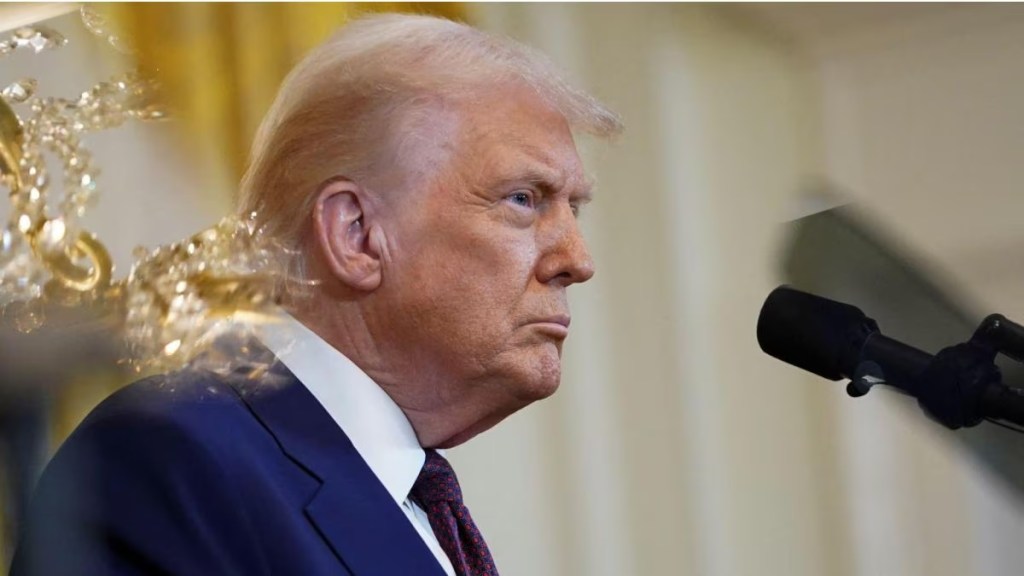By Ashok Gulati, Sulakshana Rao, Tanay Suntwal
US President Donald Trump surprised the world once again with his sudden announcement of a 90-day pause on reciprocal tariffs for countries that did not retaliate against his order on April 2. Many in the media and economic fraternity read it as his “climbdown”. To us, however, it is increasingly clear that the order was a tactic to bring its trading partners on the negotiating table. The purpose was simple — slashing the US trade deficit in goods, which was $1.2 trillion in 2024. Reciprocal tariffs, beyond the minimum base level of 10%, were designed specifically to give a tariff shock to its trading partners so that they realised its urgency. In that sense, he has already succeeded. Trump does not shy away in saying that these countries are now “kissing his a**”, and queuing up to make trade deals with the US. He claims that the trade deals will be “fair” to them as well as the US. In the process, the multilateral trading system is thrown out of the window.
Clearly, this whole game plan is specifically targeted towards China, and perhaps for the right reasons. In 2024, China exported goods worth $440 billion to the US while its imports from the US were $144 billion, creating a trade deficit of $296 billion for the US. This amounts to roughly 24% of the US trade deficit of $1.2 trillion. China is often accused of currency manipulation, keeping the Chinese yuan undervalued against the US dollar, besides non-tariff barriers. Undervalued currency is nothing but a hidden way of giving export subsidies. In that sense, the Chinese economy is not a fully market-based economy. The World Trade Organization (WTO) failed to fix this. It is no wonder that the WTO itself is becoming increasingly irrelevant.
However, the US target list may go beyond China. The next in line could be the European Union (EU), Mexico, or Vietnam — countries that inflict large trade deficits on the US. For example, the US has a deficit of $237 billion (roughly 20% of its trade deficit) with the EU, $182 billion (15%) with Mexico, and $123 billion (about 10%) with Vietnam (which has significant Chinese investments backing it). Japan, Canada, and even India also fall in this category, but India is 10th in that list ($45 billion).
There is no doubt that with Trump’s new tariff plans, China is likely to be the worst hit. Interestingly, if the current level of tariff (125%) on China stays, its exports of $440 billion to the US would drop to a trickle very soon. Given that the Chinese economy already has a huge surplus capacity, it would be scouting for alternative markets to dump its goods. No wonder China is talking of the “elephant and dragon” tango, and making friendly moves towards members of the Association of Southeast Asian Nations.
India’s trade with China is already hugely imbalanced, with the former having a trade deficit of $94 billion (Directorate General of Foreign Trade). The imports to exports ratio between India and China (88:12) is even worse than between US and China (75:25). India has to be extremely vigilant about being inundated by cheap Chinese imports as they can wipe out many domestic industries. If India has to learn any lesson here, we should look at Indonesia, which is suffering from Chinese imports. As a result, several of its domestic textile firms have shuttered, losing thousands of jobs.
The only advice we have is: Be vigilant!
Getting back to the US, our research indicates that India has an opportunity to occupy the space that China will vacate in the US, especially in labour-intensive sectors like textile and apparel (T&A), machinery, toys and games, footwear, and leather. But to tap this potential, India will have to do a lot of homework to scale up its production and adhere to high quality standards with a sole focus on US markets. Let us take the case of T&A as an example.
The US is the world’s second-largest market, after the EU, for apparel (HS 61 and 62), importing over $81.5 billion in 2023, with China being its biggest exporter. But now, with elevated tariff structures, Chinese exports to US will drastically come down. If India plays its cards right, this could be a big push towards our own $100-billion target in T&A exports by 2030.
To capitalise on this opportunity, India must address structural inefficiencies in its textile value chain. First, we must integrate the fashion component with the apparel industry. Second, it requires a shift toward man-made fibre (MMF)-based apparel, which dominates globally. However, the key MMF raw material (polyester and viscose) are among the most expensive in India due to high import duties and non-tariff barriers like quality control orders. Third, India needs to rationalise its inverted duty structures within the textile value chain to become export-competitive. Fourth, the Pradhan Mantri Mega Integrated Textile Region and Apparel (PM-Mitra) scheme, with modern infrastructure facilities, needs to be fast-tracked for scaling. Fifth, we suggest that two of the seven PM-Mitra parks — Navsari, Gujarat, and Virudhunagar, Tamil Nadu — should begin operation on a war footing. These should be export-focused, special economic zones, incentivised through export-linked schemes to tap the US market.
The writers are respectively distinguished professor, senior fellow, and research assistant at ICRIER.
Disclaimer: Views expressed are personal and do not reflect the official position or policy of FinancialExpress.com. Reproducing this content without permission is prohibited.

